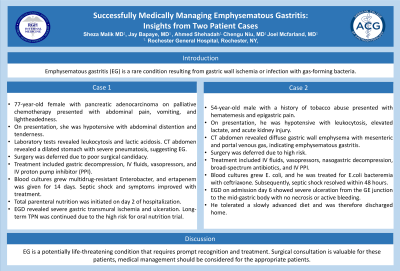Tuesday Poster Session
Category: Stomach
P4240 - Successfully Medically Managing Emphysematous Gastritis: Insights from Two Patient Cases
Tuesday, October 24, 2023
10:30 AM - 4:00 PM PT
Location: Exhibit Hall

Has Audio
- SM
Sheza Malik, MD
Rochester General Hospital
Rochester, NY
Presenting Author(s)
Sheza Malik, MD, Jay Bapaye, MD, Ahmed Shehadah, MD, Chengu Niu, MD, Joel Mcfarland, MD
Rochester General Hospital, Rochester, NY
Introduction: Emphysematous gastritis (EG) is a rare condition resulting from gastric wall ischemia or infection with gas-forming bacteria. Early diagnosis and treatment are essential to reduce the high mortality rates associated with it. Here we present two cases of EG that were successfully managed medically avoiding the need for surgery.
Case Description/Methods: Case 1: A 77-year-old female with pancreatic adenocarcinoma on palliative chemotherapy and end-stage renal disease presented with abdominal pain, vomiting, and lightheadedness. On examination, she was hypotensive with abdominal distention and tenderness. Laboratory tests revealed leukocytosis and lactic acidosis. CT abdomen revealed a dilated stomach with severe pneumatosis, suggesting EG (Figure 1). Surgery was deferred due to poor surgical candidacy. Treatment included gastric decompression, IV fluids, vasopressors, and IV proton pump inhibitor (PPI). Blood cultures grew multidrug-resistant Enterobacter, and ertapenem was given for 14 days. Septic shock and symptoms improved with treatment. Total parenteral nutrition was initiated on day 2 of hospitalization. Septic shock and symptoms improved with treatment. Total parenteral nutrition was initiated on day 2. EGD revealed severe gastric transmural ischemia and ulceration. Long-term TPN was continued due to the high risk for oral nutrition trial.
Case 2: A 54-year-old male with a history of tobacco and recent NSAID use presented with hematemesis and epigastric pain. On presentation, he was hypotensive with leukocytosis, elevated lactate, and acute kidney injury. CT abdomen revealed diffuse gastric wall emphysema with mesenteric and portal venous gas, indicating emphysematous gastritis. Surgery was deemed high-risk, so conservative management was recommended. Treatment included IV fluids, vasopressors, nasogastric decompression, broad-spectrum antibiotics, and IV PPI. Blood cultures grew E. coli, and he was treated for E.coli bacteremia with ceftriaxone. Subsequently, septic shock resolved within 48 hours. EGD on admission day 6 showed severe ulceration from the GE junction to the mid-gastric body with no necrosis or active bleeding. He tolerated a slowly advanced diet and was therefore discharged home.
Discussion: EG is a potentially life-threatening condition that requires prompt recognition and treatment. It should be highlighted that although surgical consultation is valuable for these patients, medical management should be considered for the appropriate patients.
Disclosures:
Sheza Malik, MD, Jay Bapaye, MD, Ahmed Shehadah, MD, Chengu Niu, MD, Joel Mcfarland, MD. P4240 - Successfully Medically Managing Emphysematous Gastritis: Insights from Two Patient Cases, ACG 2023 Annual Scientific Meeting Abstracts. Vancouver, BC, Canada: American College of Gastroenterology.
Rochester General Hospital, Rochester, NY
Introduction: Emphysematous gastritis (EG) is a rare condition resulting from gastric wall ischemia or infection with gas-forming bacteria. Early diagnosis and treatment are essential to reduce the high mortality rates associated with it. Here we present two cases of EG that were successfully managed medically avoiding the need for surgery.
Case Description/Methods: Case 1: A 77-year-old female with pancreatic adenocarcinoma on palliative chemotherapy and end-stage renal disease presented with abdominal pain, vomiting, and lightheadedness. On examination, she was hypotensive with abdominal distention and tenderness. Laboratory tests revealed leukocytosis and lactic acidosis. CT abdomen revealed a dilated stomach with severe pneumatosis, suggesting EG (Figure 1). Surgery was deferred due to poor surgical candidacy. Treatment included gastric decompression, IV fluids, vasopressors, and IV proton pump inhibitor (PPI). Blood cultures grew multidrug-resistant Enterobacter, and ertapenem was given for 14 days. Septic shock and symptoms improved with treatment. Total parenteral nutrition was initiated on day 2 of hospitalization. Septic shock and symptoms improved with treatment. Total parenteral nutrition was initiated on day 2. EGD revealed severe gastric transmural ischemia and ulceration. Long-term TPN was continued due to the high risk for oral nutrition trial.
Case 2: A 54-year-old male with a history of tobacco and recent NSAID use presented with hematemesis and epigastric pain. On presentation, he was hypotensive with leukocytosis, elevated lactate, and acute kidney injury. CT abdomen revealed diffuse gastric wall emphysema with mesenteric and portal venous gas, indicating emphysematous gastritis. Surgery was deemed high-risk, so conservative management was recommended. Treatment included IV fluids, vasopressors, nasogastric decompression, broad-spectrum antibiotics, and IV PPI. Blood cultures grew E. coli, and he was treated for E.coli bacteremia with ceftriaxone. Subsequently, septic shock resolved within 48 hours. EGD on admission day 6 showed severe ulceration from the GE junction to the mid-gastric body with no necrosis or active bleeding. He tolerated a slowly advanced diet and was therefore discharged home.
Discussion: EG is a potentially life-threatening condition that requires prompt recognition and treatment. It should be highlighted that although surgical consultation is valuable for these patients, medical management should be considered for the appropriate patients.
Disclosures:
Sheza Malik indicated no relevant financial relationships.
Jay Bapaye indicated no relevant financial relationships.
Ahmed Shehadah indicated no relevant financial relationships.
Chengu Niu indicated no relevant financial relationships.
Joel Mcfarland indicated no relevant financial relationships.
Sheza Malik, MD, Jay Bapaye, MD, Ahmed Shehadah, MD, Chengu Niu, MD, Joel Mcfarland, MD. P4240 - Successfully Medically Managing Emphysematous Gastritis: Insights from Two Patient Cases, ACG 2023 Annual Scientific Meeting Abstracts. Vancouver, BC, Canada: American College of Gastroenterology.
